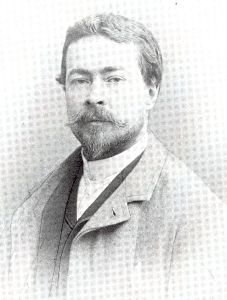

Childe Hassam Biography
Childe Hassam (1859 - 1935)
The son of a hardware merchant, Childe Hassam was born in Dorchester, Massachusetts, in 1859. His ancestors included a number of sea captains and Revolutionary War patriots. Through his mother, he was related to the novelist Nathaniel Hawthorne and through his paternal grandfather, held ties with the Hunt Family, including the Boston painter William Morris Hunt and the architect, Richard Morris Hunt.
After demonstrating an aptitude for drawing during his youth, Hassam became apprenticed to a Boston wood engraver in 1876. He was soon employed locally as a freelance illustrator, becoming a well-known figure in the profession through his work for such journals as Harper's, Century and Scribner's. Intent on developing his skills as a painter, he took evening classes at the Boston Art Club during 1877-1878 and studied privately with such artists as Dr. William Rimmer and Ignaz M. Gaugengigl. During this early period, Hassam also came under the influence of his kinsman, William Morris Hunt, who introduced him to the aesthetics of the French Barbizon School. His first noncommercial work was in watercolor, a medium that he would continue to favor for the rest of his career.
Hassam made his first trip to Europe in 1883, visiting England, France, Spain, Italy and The Netherlands. Returning to Boston, he exhibited sixty-seven watercolors at the galleries of Williams & Everett to much critical acclaim. He then began to paint the streets and parks of Boston, often depicting them under rainy or overcast skies. At that time, he employed an essentially tonalist palette of quiet browns and grays, his concerns revolving around the portrayal of light and atmospheric perspective.
Hassam made a second trip abroad in 1886, spending most of the next three years in Paris. Although he attended classes at the Académie Julian, the most formative experience of this journey leading to his eventual assimilation of Impressionist tenets. While in Paris, Hassam showed successfully at a number of exhibitions, including the Paris Salon, the Exposition Universelle (where he received a bronze medal) and at the noted Galerie Georges Petit.
Returning to America in the fall of 1889, Hassam settled in New York City. He continued to pursue his interest in Impressionism, quickly developing a style characterized by brilliant light, vivid color and shimmering brushwork yet still reflecting his concern for descriptive realism. During the summer of 1890, he made his first visit to Appledore, one of the small islands off the New Hampshire coast. He continued these annual excursions for over twenty years, producing what the scholar Donelson Hoopes has referred to as works that "possess a conviction and palpability of light and atmosphere that transformed this unremarkable little island into an American Etretat."
By the early 1900's, critics such as Albert Gallatin were proclaiming that Hassam was "beyond any doubt the greatest exponent of Impressionism in America." Throughout the course of his career, Hassam explored such subjects as New York street scenes, New England landscapes, interior genre subjects and during the first world war, his famed series of flag paintings. In 1904, 1908 and 1914, he made trips to the American West, painting in California and Oregon, where he was deeply inspired by the clear blue skies and the rolling landscape. In some of his later work, he began to experiment with pure color, simplified compositions and elongated brushwork, reflecting his awareness of Post-Impressionist design principles. After 1915, he developed an interest in printmaking, etching in particular. He quickly acquired a firm command of graphic techniques, which he pursued with skill and acumen, for the rest of his life.
Childe Hassam remained an influential and prolific artist throughout his career. In 1898, he helped found the Ten American Painters, a group of artists who seceded from the Society of American Artists in order to show their work in small, non-juried exhibitions held annually form 1898 until 1918. The membership consisted of such eminent painters as John Henry Twachtman, J. Alden Weir and Thomas Dewing. Hassam was also affiliated with the New York Water Color Club, which he helped establish, the American Water Color Society and the Pastel Society of New York. He was a regular contributor to the exhibitions of the National Academy of Design, the Pennsylvania Academy of Fine Arts and the Carnegie International.
Childe Hassam made East Hampton, Long Island, his permanent summer residence in 1919. He died there in 1935. A year after his death, at the convocation given in his honor by the American Academy of Arts and Letters, the eminent critic Royal Cortissoz described him as having had the "American way of profiting by European example without falling victim to European convention."
Return to the Childe Hassam Gallery
Please spend some time roaming our other galleries.
Artist Galleries A - F
Artist Galleries G - P
Artist Galleries Q - Z
Home Galleries by Subject Galleries by Artist Contact Us How to Order

All Rights Reserved to Canvas Replicas. 2016, 2017